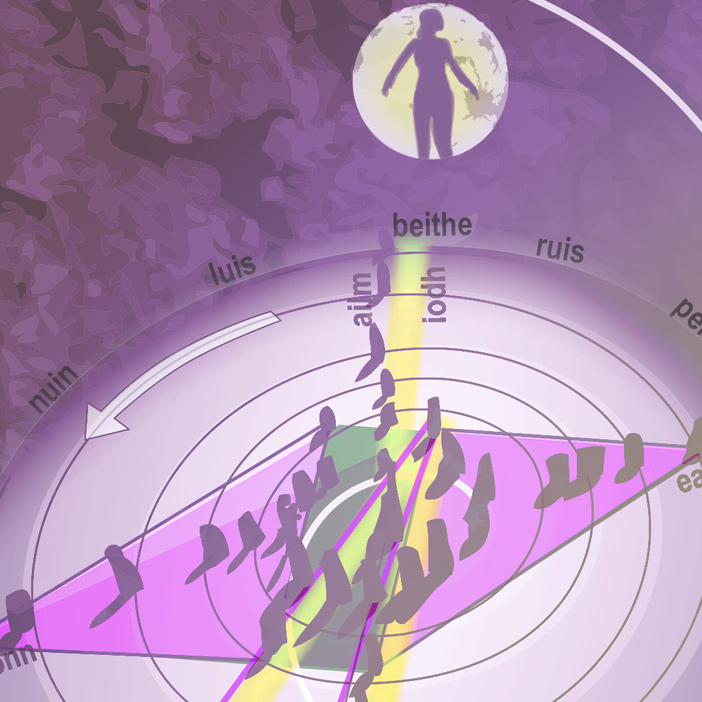
B L N F S H D T C M G P R A O U E I

A key purpose of this tree alphabet connects memory to time through tree letters. Thirteen trees (the consonants) correspond to thirteen lunar periods that follow an anti-clockwise direction. Known as a sidereal clock, each lunar period is twenty eight days, with a total of 364 days in the year (leaving the 'and a day' found in many stories!)
The five vowels follow a solar (sun-wise) direction, tracking the solstice and equinox points. Two of them define midwinter, which might seem puzzling until it is seen that they form the beginning and the end of a year (hard to me grasp when seen in 2D!) There is a further letter that tracks the nineteen year Metonic cycle, when solar and lunar cycles re-calibrate (see below).


The following is taken from geo.org/callan.htm where photographs and fuller detail can be seen. It is repeated here only in case the original source disappears!
Margaret R. Curtis, expert and tour guide of the Callanish area, recounts her experience of
this
amazing phenomenon. "We
saw this rare and spectacular event in June 1987 with friends from across the world. None of us will ever
forget the
beauty of that calm, clear summer night. Even after years of scientific study, we had never anticipated the
wonder
and
drama of the event itself. The most awe-inspiring moment of all was when the moon reappeared inside the
circle."
"For three minutes, never revealing more than half of its orb in the narrow gap. The moon was captured in an
artificial
frame of megaliths, and the cold gray pillars of stone were bathed in a golden glow.
"Like a lighthouse beam, the moonlight stretched down along the avenue towards us and caught us in its
light. Next,
a
tiny human figure appeared, fitting inside the honey colored moon, then gradually grew, shattering one's
sense of
scale,
until twice the size of the moon. Then the moon vanished and left the person majestic and alone inside the
darkened
circle.
"Was this the new-born moon god inside the sacred ring of stones reappearing as in prehistoric times, mixing
reality
and
illusion when the person may have been an actor or actress, or a member of the elite, passing on the
leadership to a
new
office bearer? Was this the origin of the legend of 'The Shining One' walking up the avenue?"

Calanais (Callanish, or Turusachan) is a 5,000 years old computer. A hint of this is
mentioned by the greek writer, Diodorus, in 55BC:
"..there is also on the isand... a notable temple which is... spherical in shape... the moon, as viewed
from this island, appears but a little distance from the earth... the god visits the island every
nineteen years..."
A Golden Year, or Metonic Cycle, occurs every nineteen (18.62) years, when lunar and solar cycles fully synchronise in what is termed a 13:5:19 logic. Here at Calanais this logic can be seen. It pivots on stone number 9, which then integrates to the double line of its nineteen stones that together define the major moonrise "..that the god visits every nineteen years". Whilst fuller detail on this subject is much best left to the excellent work of Robin Heath, Gerald Ponting and others, there remains an intriguing possibility not mentioned by them that is related to trees.


Perhaps indirectly, the Calanis circle could easily describe the Tree Alphabet's thirteen months and five vowels, represented in its circle and radial lines. Fanciful? It is worth remembering that when built 5,000 years ago, the climate was warmer and researchers detected pollen of birch and hazel during their excavations in the peat. Use and knowledge of trees would have been pre-requisites to any stone circle and its architectural or 'planning stage' would almost certainly have been wooden before being 'fixed' in stone. This is where computers and calendars come in. To make a calendar, any time sequence would need to follow an anti-clockwise order in order to tie to lunar and solar rhythms. Marking the standstill extremes and repeated rhythmns would require exact markings or 'station stone' points.
Whilst not as obvious as the station stone rectangle at Stonehenge, Calanais has a 'station romboid' made up of two slightly separated triangles. The tips of these two 'wings', here marked with their vowels, correspond to annual Spring and Autumn equinoxes, whilst the major lunar standstill event, the Golden Year "when the god visits", is marked here by the double column of nineteen stones along the north passageway. Station stone number 34, which would therefore represent this occasional yet significant point, might suggest the need to accommodate one extra tree letter. We therefore suggest the letter 'q' for Queirt / Apple to fit this correspondance that effectively rounds out the nineteen significance.


Cup and ring marks are found throughout the north and most particularly in the Kilmartin area of Argyll. Could their hallmark shape perhaps follow a possible connection to the Golden Year, or even more specifically, commemorate the completion of druidic apprenticeship (which was nineteen years)
Stonehenge is too vast a subject for comparison here, yet one obvious connection with Calanais is that the Aubrey Circle of 56 holes surrounding Stonehenge has similar calendrical purpose. Moving 2 holes per day, one circuit completes a lunar month of 28 days. Since all stone circles involve calendrical calculation, could there have been connection to the use of tree letter mnemonics? If so, it might explain another piece of the jigsaw - the introduction of Ogham - which may have been conceived as a useful adaptation of the Tree Alphabet by Palladius in c 450 AD, when he is understood to have initiated Ogham in Ireland, later taking it to the Mearns in Aberdeenshire.
